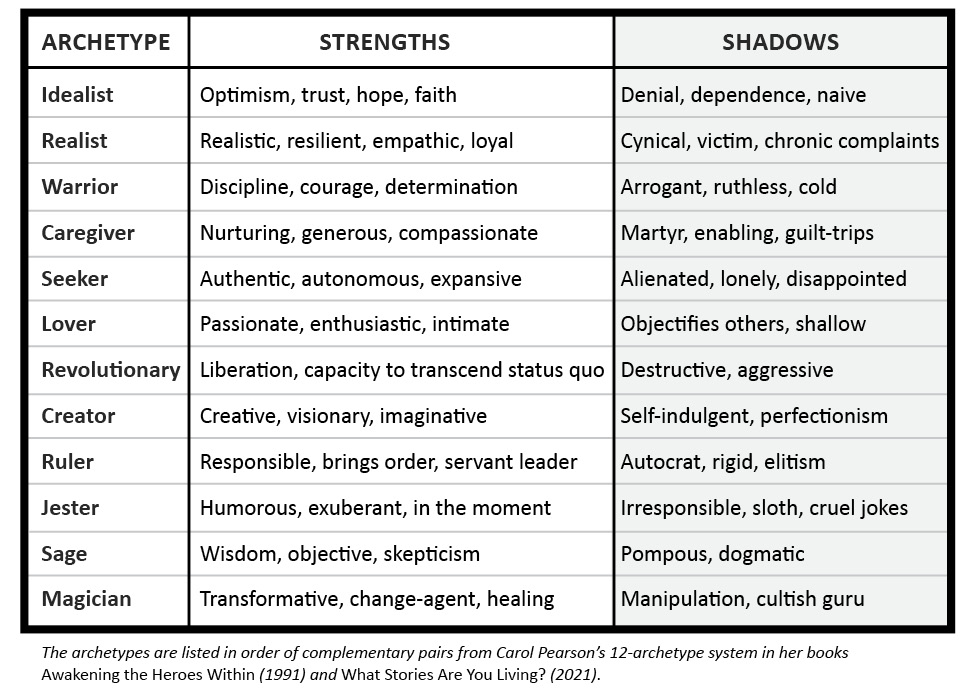Growing With Your Archetypes: Allies
The Pearson-Marr reports and Dr. Pearson’s book What Stories Are You Living? (2021) interpret a person’s Archetype Profile through three categories: high scoring archetypes as Allies, mid-range archetypes as a Treasure Chest, and low-scoring archetypes as Blind Spots. In this article, I will discuss how to work with your Allies for self-growth and development. In future articles, I will discuss working with your Treasure Chest and Blind Spots.
The top scoring archetypes are called Allies. In the PMAI® reports, we have rather arbitrarily selected the top three as Allies, but you can include more, or less archetypes in this category if that makes the most sense to you. High scoring archetypes represent characteristics that you likely identify with and narratives that you use the most to understand and engage the world; because of this, your Allies are where you are most skilled and developed. We look to our Allies to understand our core gifts and strengths; they point to where we contribute value to others, our work, and ourselves. When we tilt our lives to focus on and engage our Allies, we experience reward and satisfaction. Identify how your Allies are showing up in your work life and your relationships. How often does your job or organization ask for or need the skills and perceptions of your Allies? A career that calls on our archetypal Allies brings satisfaction. Are your Allies at the heart of your relationships? When the characteristics and talents of our Allies are a foundation of our relationships, we feel authentic. Being in relationships with people who know and care for who we really are is rewarding.
The deepest work with Allies, however, is in understanding and working with shadow aspects. In Jungian psychology and the Pearson-Marr system, shadow refers to aspects of ourselves that we are typically not aware of because they have a negative expression or could be positive but are not valued by us. For example, a person with a high scoring Jester may be aware of their gifts with humor, cleverness, and the ability to bring levity and insight into situations, but they may not be aware of the times people experience Jesters as dismissive of their problems or challenges. Yet, when a Jester does become aware of when they are acting this way and works on understanding both what is motivating it and how it impacts people, they develop more compassion and depth. This brings the Jester the deeper gift of using humor to connect with others and alleviate suffering through a connection with someone who understands.
There is a key point in shadow work: when we work with our shadow through awareness, acceptance, and action, we transform ourselves in such a way that we deepen our gifts. A Jester who works with shadow aspects that use humor to hurt others becomes a person who can use humor to heal. A Lover who becomes aware of and acts to change a shadow tendency to be dependent on others to know who they are, is transformed into a Lover who brings their full self as an equal in relationships.
To work with your Allies, try this:
•Reflect on where the characteristics, gifts, strengths, and ways of perceiving represented by our Allies are called on in important areas of your life. What do you see—is a sense of dissatisfaction a sign that your Allies are not engaged enough, needed, or present? Think of changes you can make to tilt your life towards your Allies.
•Read about your Allies’ strengths and shadows in the chart below and in What Stories Are You Living? Discover Your Archetypes – Transform Your Life! Commit to your growth by becoming more aware and more accepting of yourself. Do not be embarrassed or avoid your shadow aspects—it is only human!
We feel best when we are growing and learning. Shift into a growth mindset and set out consciously on a journey of self-discovery. In the grand adventure of your life, your Allies show you the gifts you have for the world.













_thumb.png)
_thumb.png)
